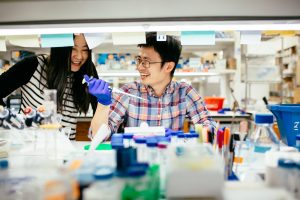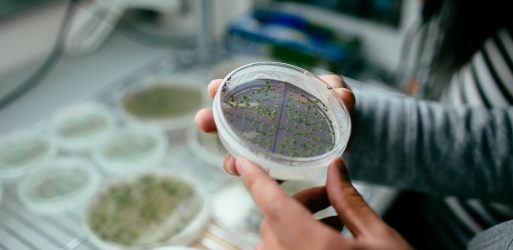Genetics researchers at the University of Wisconsin—Madison’s Wisconsin Institute for Discovery have identified a new role played by a pair of enzymes in the production of proteins in plant cells.
Postdoctoral researcher Xiangsong Chen is the lead author of an article in the January issue of Plant Cell in which he describes how two Arabidopsis thaliana histone deacetylases operate to preserve normal ribosome function, both through regulation of rRNA processing-related genes and by binding directly to rRNA itself.
Ribosomes, made up of proteins and ribosomal RNA (rRNA), are the assembly-line workers of all living cells, responsible for chaining amino acids together into proteins based on the instructions encoded in an organism’s DNA. Those instructions—delivered in the form of precursor RNAs—must be correctly processed into mature rRNAs in order for protein synthesis to occur correctly; errors in the process lead to developmental defects and diseases. In other words, ribosomes are critical for the growth, health, and survival of living things.
Appropriate ribosomal function depends on expression of genes that code for rRNA, a process that is ruled by epigenetic factors. Genes—including genes responsible for creating ribosomes—can be turned on and off, depending on complex chemical signals. Histones, which are protein structures around which DNA is tightly wrapped, play a central role in gene regulation: genes can be turned on or off when histones are modified by chemical tags which may uncoil or more tightly wind DNA to make a given region and the genes it contains more or less likely to be expressed.

In a recent study, Chen and his collaborators in Assistant Professor Xuehua Zhong’s lab found that mutants of the plant-specific histone deacetylases HD2C and HD2B resulted in abnormal rRNA processing. The deficiency suggests that these enzymes are important components of the epigenetic machinery regulating the expression of genes related to rRNA processing. Chen, who studies the functions and mechanisms of histone modifiers in plant development and environmental response, was unsurprised to discover the previously uncharacterized role of these specific histone deacetylases in the transcription process.
What was surprising was that HD2B and HD2C’s influence did not stop there. Chen also found that histone deacetylases can act in a second way to influence rRNA processing: HD2C can directly bind to rRNA and prevent rRNA methylation. This second regulatory mechanism intervening at the translational stage seems to ensure that rRNA processing occurs normally. Without the enzymes, ribosomes produce dysfunctional proteins and leaf and root development can be negatively impacted.
This kind of “one-two punch” combining influence both epigenetically and directly via the ribosome has not been reported before. The finding leads to questions about the evolution of rRNA processing regulation, the possibility of similar dual-regulatory systems existing outside the plant kingdom, and the interplay of environment and ribosomal regulation.
Based on other researchers’ findings that HD2C and HD2B play a role in stress response, Chen suspects that the enzymes might help plants conserve resources during times of stress by slowing protein production and pausing organism development.
The study is available as an advance publication for the January issue of Plant Cell.
This work is supported by the Alexander von Humboldt Foundation (Alfred Toepfer Faculty Fellow), an NSF CAREER award (MCB-1552455), and NIH-NIGMS (R35GM124806). Work in LMS’s laboratory was supported by NIH-NIGMS (R01GM114292).
– Nolan Lendved


You must be logged in to post a comment.